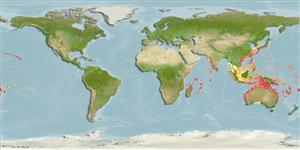Malacostraca |
Decapoda |
Scyllaridae
Environment: milieu / climate zone / depth range / distribution range
Ecology
Reef-associated; depth range 0 - 80 m (Ref. 4), usually 20 - 50 m (Ref. 4). Tropical; 36°N - 34°S, 30°E - 150°W
Indo-Pacific: from South Africa north to Japan, south to Australia and east to Hawaii.
Length at first maturity / Size / Weight / Age
Maturity: Lm ? range ? - ? cm Max length : 40.0 cm TL male/unsexed; (Ref. 4)
It has lengths of 40 cm, maximum total body length; 15 cm, carapace length (Ref. 4). Fisheries: commercial (Ref. 91361). Minimum depth reported taken from Ref. 9773. Nocturnal (Ref. 4). Opens bivalves through an attack known as wedging. That is, it pries apart the shell lips via its walking legs (Ref. 102680).
Life cycle and mating behavior
Maturity | Reproduction | Spawning | Eggs | Fecundity | Larvae
Members of the order Decapoda are mostly gonochoric. Mating behavior: Precopulatory courtship ritual is common (through olfactory and tactile cues); usually indirect sperm transfer.
Holthuis, L.B. 1991 FAO Species Catalogue. Vol. 13. Marine lobsters of the world. An annotated and illustrated catalogue of species of interest to fisheries known to date. FAO Fish. Synop. 125(13):292p. Rome: FAO. (Ref. 4)
IUCN Red List Status
(Ref. 130435: Version 2025-1)
CITES status (Ref. 108899)
Not Evaluated
Not Evaluated
Threat to humans
Human uses
Fisheries: commercial
| FishSource |
Tools
More information
Population dynamicsGrowth
Max. ages / sizes
Length-weight rel.
Length-length rel.
Length-frequencies
Mass conversion
Abundance
PhysiologyOxygen consumption
Human RelatedStamps, coins, misc.
Internet sources
Estimates based on models
Preferred temperature
(Ref.
115969): 21.5 - 28.6, mean 27.2 (based on 534 cells).
Fishing Vulnerability
Low to moderate vulnerability (30 of 100).
